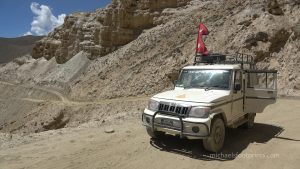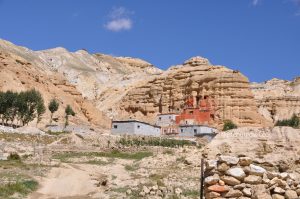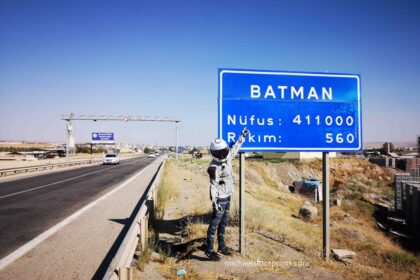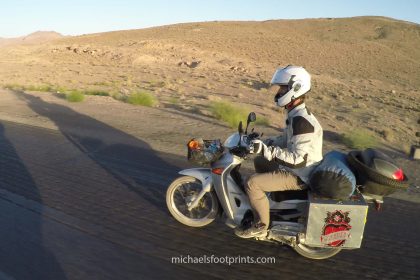Mustang is a region in Nepal north of the high Himalayan peaks. It used to be the “Kingdom of Mustang” within Nepal, but lost its status in 2008 due to the Maoist civil war. What makes Upper Mustang so unique is the fact that it used to have close ties to Tibet, but was not forced to change much after the annexation by Nepal. The locals still speak Tibetan, the villages and houses are still built in Tibetan style and the religion is also the same form of Buddhism. So many people, including the locals we talked to, say Mustang has been better preserved than their Motherland, which now belongs to China. Besides the rich culture, the second thing that makes this region worth visiting is the absolutely amazing landscapes, which I immediately fell in love with. In this article I will be showing you how to get into Upper Mustang, and why it’s worth the effort.

Inside Mustang
Upper Mustang (North of Kagbeni) is a restricted area to tourists. See below for information on how to get into Upper Mustang.
There are a few ways to travel within this area. I think the most rewarding version is hiking the whole way. A surprisingly big part of the tourists do this. We also saw a group of mountain bikers and two tourists on horses. We had not planned on coming here and only came up with this idea while we were in Pokhara. As there was not much time left in our trip we did not have time left to hike the whole way. We did the tour in a 4WD. It was less expensive than I would have expected, but the experience is certainly not the same as walking.

There is basically only one street Upper Mustang, and it is fairly new. The government has sent hundreds of workers from the south of Nepal to make it. It is basically a dirt road on mountains made of sand and dust. So now that the road has actually been finished the workers keep fixing the parts that slide away or get buried under falling rocks. To be honest this road is a far cry from safe but the drivers really make up for this with a lot of skill and agility. This means something coming from someone who grew up in the Swiss Alps. The bus ride into the area is much worse though, but more on that later. Of course, I love this wild ride it made the trip an adventure. Nobody with back problems should consider this though. See my video (coming soon) for some impressions.

In the picture above the road is in a quite good state, but the fallen rock made it a bit narrow for a 4WD. And it’s always hard to tell how far you can go with the car before the ground starts breaking away beneath the tire.
Do not expect anything fancy from the hotels. The rooms are cold (we were there in summer), there is no toilet paper and if you want to charge your batteries you will undoubtedly hear “oh, sorry, only sometimes” as the locals try to say that they only have electricity for a few hours a day. Surprisingly, many hotels have solar panels but only just enough to make the lights work all day. So they will not let you charge your cameras with the solar electricity. It is actually surprising that they even have electricity from far away at all. In the hotels the bottled water is ridiculously expensive and in the small shops in the villages it is not cheap either. If you are coming in a 4WD from the south load it up with plenty of bottles (or of course a filter) and bring toilet paper.
Consider simplicity the charm of off the beaten path travel (although packing toilet paper is always a good idea – even in Europe).
By the way the locals use dried dung to make fires for cooking and heating. The lack of trees and electricity forces them to do this. I was surprised to find that this method does not stink at all.

My favorite village is named Ghami. It is Upper Mustang the way I imagined it. A very calm oasis in the rugged landscape, where everybody lives a simple life. The locals live off of their livestock and everything they can grow. The cows are very small and the calves are absolutely tiny. But undoubtedly the enormous herds of goats are what I will always remember when I think of Mustang.

I would in any case avoid staying in Tsarang. It is not very nice compared to the other villages. If your (young) tour guide insists on staying there, it is probably because there is a room with three pool tables in perfect condition. Do not ask me how they got there or how they were paid for. If this is your thing, go for it. In my case I prefer a Mustang without western influence. Then again if you are walking, you might have to spend a night there. The towns are not exactly near to each other.
Lo Mantang is the capital of the region. While it is not too touristy yet, this is the place where you see that they expect to become so soon. It is full of tourist shops and this was the only place we stayed at, where shop owners actively tried to get you to come inside. But even here the only place that said they had wifi couldn’t get any connection good enough to open google.com. Expect to be offline the complete time you are here including cell phone connection. This is also the town where we could find postcards with “Kingdom of Mustang” written on them… only a title used for tourists nowadays.

A further thing worth seeing iget ins Garphu near the border to the autonomous region of Tibet. Here there is the beautiful Nyphu Gumpa. In my personal opinion the gumpas (temples) of Mustang are all prettier from the outside than the inside. Even though they are religious sites that are still used by the monks they are not taken care of very well. One monk, who was very friendly and spoke the best English of all the people we met, threw rice corns at things he was explaining inside the gumpa (instead of just pointing at them). He later gave me slates with some Tibetan writing on them. I have no clue what they were made of and neither did he. When he told me they were more than 700 years old I couldn’t believe they I was just holding them in my bare hands. I cannot say if they were really that old, but they did look ancient. So to sum up it was all a bit weird. Oh and did I mention the old, rusty car battery in the middle of the gumpa being charged by solar panels. A real fire hazard. But as always in these places, magically, nothing ever happens.

And right next to this Gumpa there are the Garphu Caves. These caves are high up in the cliffs and used to be inhabited by humans a long time ago. There are many of these caves in Mustang but these are the only ones that seemed accessible without climbing.
I can almost only say good things about this remote region of the world, but unfortunately I must mention this (the point I was not expecting): Many locals were not very friendly. For instance we had locals in the back of our jeep on fold down chairs on many occasions. They drove with us for free. And they never showed any form of appreciation. I know they might not know the words “Hello” or “Thank you” but even when I got out to open the door, that only opened from the outside, they got out and walked past me without even looking me in the eye. I have been to Asia many times before, but this was new to me. Usually the further you get from tourism the friendlier the locals become. This was not the case here.
How to get into Upper Mustang
In order to access the region three permits are needed. The Annapurna Conservation Area permit, a TIMS-card (general hiking permit) and the restricted area permit for upper mustang (only needed north of Kagbeni) are necessary for this trip. No need to worry about these though because you may not enter the region without a tour guide anyway and they organize these for you.
 These are the Permits for upper Mustang. It turns out that there is a restricted are within Mustang that this permit will not get you to. I have no clue where it is or what is there. I only found out about it when I was there and read my permits for the first time. The fact that somebody wrote “Swedish” instead of “Swiss” gave us a bit of a hard time at the checkpoint in Kagbeni.
These are the Permits for upper Mustang. It turns out that there is a restricted are within Mustang that this permit will not get you to. I have no clue where it is or what is there. I only found out about it when I was there and read my permits for the first time. The fact that somebody wrote “Swedish” instead of “Swiss” gave us a bit of a hard time at the checkpoint in Kagbeni.
The organizer wanted us to send our original passports to him. Which I absolutely didn’t want to do (we were in Pokhara and he was in Kathmandu). When it had gotten too late for us to be able to send them to him on time he settled for pictures of our passport. I am not sure if this is normal though, or if he had to pull some strings to get the permit with only our pictures. The good thing about the restricted area permit is that it keeps out mass tourism, simply by costing a staggering 500USD (valid for 10 days after entering). The downside is obviously that it’s a big amount of money and plus I am not so sure where this money goes. I met a French man who was working in the region for an NGO, who was helping some locals with watering systems. And his organization had to fork over the money for his entry too… Every time he went to the region… And also a local monk told me they don’t see any of this money in the region either. To be fair though maybe it’s all going into the road that’s being built by the workers from the Terai in southern Nepal.

Here’s a group of workers. And there are dozens of groups like this. They live under self-made tents in this sandy and constantly windy landscape.
m
The region could theoretically be entered through the north (Tibet). Online it seems very clear that this border is permanently closed. But the locals seem to know better and all told me it is open one day per year – some even mentioned two days. Some even claimed to have crossed this border in recent years. So maybe, just maybe, this is an option for you. In any case this will take a lot of frustrating e-Mails. But Lhasa-Mustang-Kathmandu would certainly be a rewarding route.
When coming from the south there are basically two ways to get in. By land (bus or jeep) or simply by flying in to Jomsom (only domestic flights).
We took a 4WD on the way in and a bus on the way back. I enjoyed the ride from Beni (not to be confused with Kagbeni) to Jomsom very much. The scenery is breathtaking and the shift in vegetation from lush green tropics to the high “desert” of Tibet is an experience to itself. The road leads through the Kali Gandaki Gorge which is the deepest in the world (disputed), as it separates the Dhaulagiri from the Annapurna which are both over 8000m (2600ft).
The ride is very bumpy and when it’s wet the roads get muddy. The path is very narrow and there is almost always a massive drop-off on one side. The mud makes the bus roll backwards at least once on just about any incline. This would all be ok, but the problem is that the streets are usually only just narrow enough to fit one bus. So any movement backwards can give you quite a kick. But I must be honest, these drivers – like the ones within Upper Mustang – are amazing.

Here the people are trying to get their bus up the hill. Luckily the road is quite wide here. By the way just bcause it says tourist does not mean there are many tourists on board. They just try to attract some like this.
I would drive one way, provided your back is ok and you like a little adventure, and fly the other way. Because the drive goes forever and takes its toll. Driving in is nicer as it gives you a feel for how remote the place is. It’s worth mentioning that flights are very frequently cancelled due to weather problems.
Summed up
The “Kingdom of Mustang” is the place to go if you want to discover a corner on the map which basically nobody knows exists. The barren Landscapes are by far the most impressive I have ever seen (including the US-West). And despite this remoteness there is such thing as very basic tourist infrastructure. Many would say this is Tibet as it once was – something I plan to find out for myself. Coming here was worth every cent.












